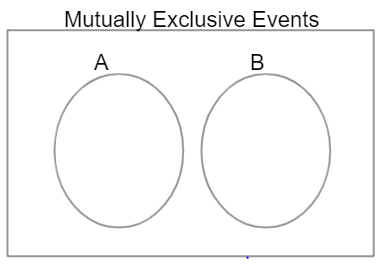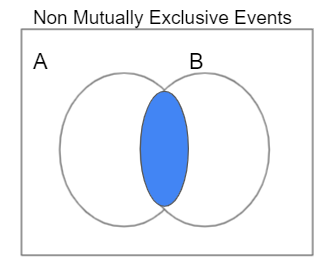In probability, two events are mutually exclusive when it is not possible to happen both events at the same time. Mutually exclusive events are also called disjoint events. Find the definition of mutually exclusive events and their examples in the below sections. You can also check the probability rules, conditional probability and solved questions.
What are Mutually Exclusive Events?
If two events and cannot occur simultaneously in any random experiment are said to be mutually exclusive events. Mutually exclusive events are called disjoint events. If A and B are two mutually exclusive events, then A ∩ B = ∅. The probability of disjoint or mutually exclusive events is always zero.
Example:
When you toss a coin, you will get the outcome either head or tail, but there is no chance of getting both results at a time. This is an example of mutually exclusive events. Another example is rolling a die, even face and odd face are mutually exclusive events.
Addition Theorem on Mutually Exclusive Events
If A and B are two mutually exclusive events, then the probability of A union B is the sum of the probability of A and probability of B.
P(A U B) = P(A) + P(B)
Proof:
Consider a random experiment E, N(A) is the number of frequency of the event A in E. Since A and B are mutually exclusive events
N(A U B) = N(A) + N(B)
Or, \(\frac { N(A U B) }{ N } \) = \(\frac { N(A) }{ N } \) + \(\frac { N(B) }{ N } \) [Divide both sides by N]
Now taking limit N to ∞, we get the probability of
P(A U B) = P(A) + P(B)
Probability Rules of Mutually Exclusive Events
In probability, two events are said to be mutually exclusive or disjoint if they do not occur simultaneously. One of the best examples is the set of outcomes of tossing a coin, which can get either head or tail but not both. While flipping a coin, both results are collectively exhaustive, which suggest that at least one of the consequences happen, so two probabilities collective;y exhaust all the probabilities. Though, all non mutually exclusive events are commonly exhaustive. These rules of probability are concluded.
- Addition Rule: P(A + B) = 1
- Subtraction Rule: P(A U B) = 0
- Multiplication Rule P(A ∩ B) = 0
How to Show Mutually Exclusive Events?
Here we are using Venn diagrams to represent that two events are mutually exclusive to each other. The following figures indicate mutually exclusive and not mutually exclusive events. The important point is there is no common element in both events.


Conditional Probability for Mutually Exclusive Events
Conditional probability is the probability of an event A, and another event B has occurred. For two independent events, A, B the conditional probability f B and A has occurred is represented as P(B|A) and it is defined as P(B|A) = P(A ∩ B)/P(A)
We know thta P(A ∩ B) = 0
P(B|A) = 0/p(A)
Therefore, the conditional probability formula of mutually exclusive events is P(B|A) = 0.
Example Questions & Solutions
Question 1:
Caroline noticed her mother trying to take out the fish to clean the fish tank. She asked her mother, “How many are males and how many are females?” Her mother replied that the tank contained 8 male fish and 15 female fish. What is the probability that the fish her mother takes out first is a male fish?
Solution:
Probability of an event = \(\frac { Number of Possible Outcomes }{ Total No of Favorable Outcomes } \)
Number of male fishes = 8
Number of female fishes = 15
Total no of fishes = 8 + 15 = 23
P(male fish) = \(\frac { 8 }{ 23 } \)
Therefore, the probability that the fish are taken out is a male fish is \(\frac { 8 }{ 23 } \)
Question 2:
What is the probability of a die showing a number 3 or number 5?
Solution:
P(3) is the probability of getting a number 3
P(5) is the probability of getting a number 5
P(3) = 1/6 and P(5) = 1/6
So, P(3 or 5) = P(3) + P(5)
P(3 or 5) = (1/6) + (1/6) = 2/6
P(3 or 5) = 1/3
Therefore, the probability of a die showing 3 or 5 is 1/3.
FAQ’s on Mutually Exclusive Events
1. What are 2 mutually exclusive events?
Mutually exclusive events are events that can’t occur at the same time. An example is a student who wants to go to school and there are two paths. So that he can choose only one path and he can’t choose both at the same time.
2. How to know if two events are mutually exclusive?
2 events are mutually exclusive if they cannot happen simultaneously. The probability of either occurring is the sum of the probabilities of each occurring event.
3. What is mutually exclusive events formula?
The mutually exclusive events formula is P(A U B) = P(A) + P(B).
4. Are E and F mutually exclusive?
Two events E and F are mutually exclusive if two events have no outcome in common.